Bearded Iris Growing Tips From Award-Winning Grower Simon Dodsworth
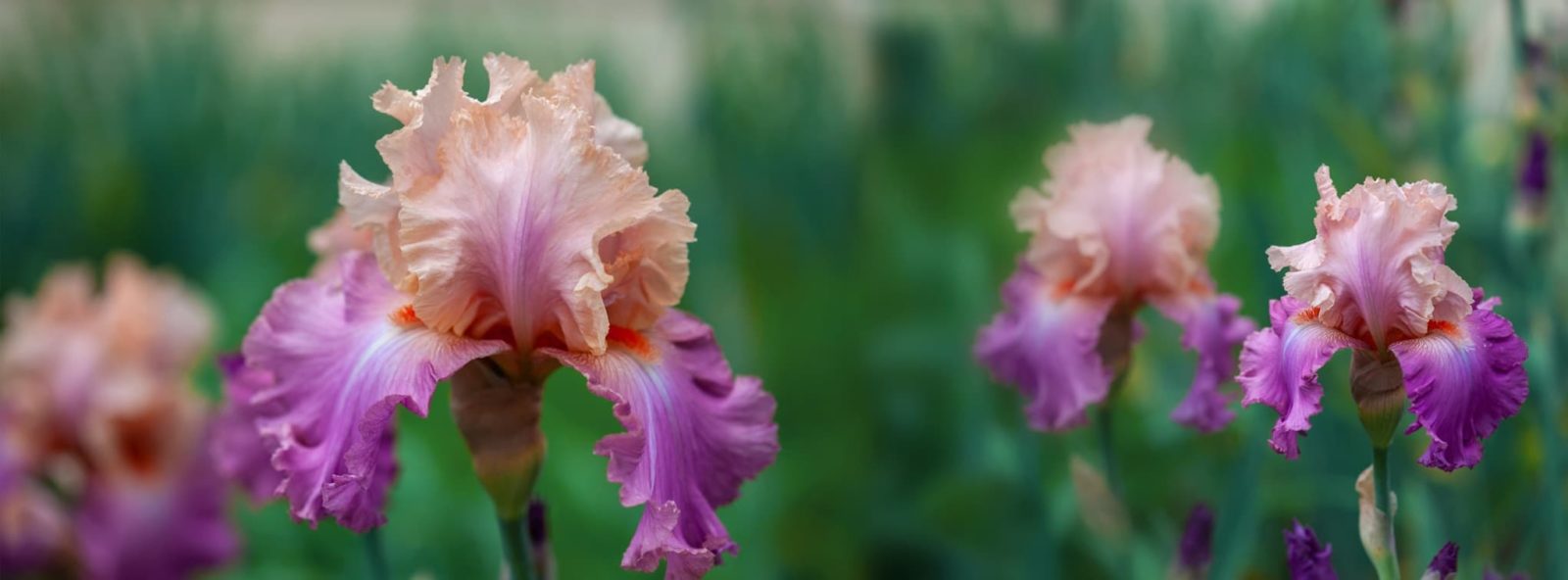
BULBS > BEARDED-IRIS
Reviewed By PETER LICKORISH

Peter is a Horticulture Lecturer and self-employed Horticulturist, with a passion for diverse areas of the industry - from garden design to the science behind plant growth and propagation. He has completed the Royal Horticultural Society’s Master of Horticulture (MHort) Award and lectures on RHS courses at Bedford College.
Contributions From SIMON DODSWORTH
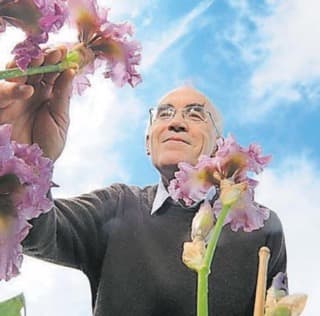
Simon is the Founder of The English Iris Company, an award-winning plant nursery based in the UK. In 2015, his nursery’s iris collection was awarded National Collection status by Plant Heritage. More recently, the nursery provided irises that featured in the Gold Winning British Iris Society Centenary Stand at the RHS Chelsea Flower Show in 2022.
IN THIS GUIDE
One of those flowering plants that needs no introduction, Iris includes among its categories a type that is a garden classic and favourite: Bearded Iris.
This rhizomatous plant is remarkably fuss-free about soil, watering or anything else – though it is important to get the basics right.
The plant bears breathtakingly beautiful blooms that have a vertical orientation and come in an astonishing range of hues, with many cultivars producing even multi-coloured, patterned flowers.
Across our Iris guides, you’ll notice we have sought advice from Simon Dodsworth, the Founder of The English Iris Company.
“Tall Bearded Irises are spectacular flowers and really can help lift the spirits,” says Simon.
“They are also easy to grow and bulk up well and, with a little TLC, will last for years and years.”
Overview
| Botanical Name | Iris germanica |
| Common Name(s) | Bearded Iris |
| Plant Type | Bulbs / Perennial |
| Native Area | Mediterranean |
| Hardiness Rating | H6 |
| Foliage | Upright and evergreen |
| Flowers | Upright and dropping petals. Fragrant, showy flowers |
| Flowering Months | May, June |
Sunlight
Preferred
Full Sun
Exposure
Exposed or Sheltered
Size
Height
0.5 – 1M
Spread
0.1 – 0.5M
Bloom Time
May – June
Soil
Preferred
Clay, loam, sand
Moisture
Moist but well-drained
pH
Neutral / Alkaline
The Iris genus is classified under Family Iridaceae.1Iris x germanica. (n.d.). North Carolina Plant Toolbox. Retrieved March 13, 2023, from https://plants.ces.ncsu.edu/plants/iris-x-germanica/
This family is one of those that takes pride of place among the families of flowering plants because it includes – besides Iris – crocus, gladiolus, freesi, and even more flowering plants.
Like Irises, many of these other genera include herbaceous perennials.
Similar to those genera, Iris bears long strap-like or sword-shaped leaves of a sea-green or bright green hue, sometimes with a bluish tinge.

These leaves grow in a ‘fanned-out’ arrangement.
Iris species occur almost throughout Asia, Europe, and North America.2Iris × germanica. (n.d.). Kew Royal Botanic Gardens. Retrieved March 13, 2023, from https://powo.science.kew.org/taxon/urn:lsid:ipni.org:names:438637-1
How To Grow Bearded Iris
Bearded Irises by themselves, let alone other types of Irises, offer such a wealth of diversity in plant size, flower size, and floral colour (and also blooming season and fragrance) that you can grow them pretty much “wherever you please” – though there are some non-negotiables for healthy plants.
“Importantly, irises flower at a key time in the gardening calendar and fill the gap left between the last of the spring bulbs and the first species of roses,” explains Simon.
“For this reason, they merit a place in all our gardens.”
Where you can or should plant Iris is limited only by your imagination.
A mass planting of mixed bearded Iris in a good-sized bed will provide a truly breathtaking vista of floral form with fantastic colour.
They are excellent choices for a mixed bed too provided you pick the right companion plants.

As general guidelines, the taller varieties with their large flowers are very suitable for the rears of beds while the shorter ones are perfect for courtyard gardens.
Intermediate-height Irises are usually perfect as companion plants – intermediate and dwarf varieties are also great for borders.
Reserve the visually stunning ones such as the taller varieties with near-black, high contrast, and vivid ‘self’ – so to speak – flowers as specimen plants to be planted in containers and set by the doorway or on the veranda or the patio.
It must be said that Bearded Iris is that rare plant that is almost as at home in a formal garden as it is in a cottage garden, thanks to the geometric leaf shapes.
Planting Rhizomes
Bearded Irises are most commonly – and very easily – grown from rhizomes.
Though it can be an exercise in pampering and frustration to grow Iris from seed, there’s absolutely nothing to growing Irises from rhizomes.
Rhizomes can be planted after they have started to sprout leaves and even push up flower stalks.
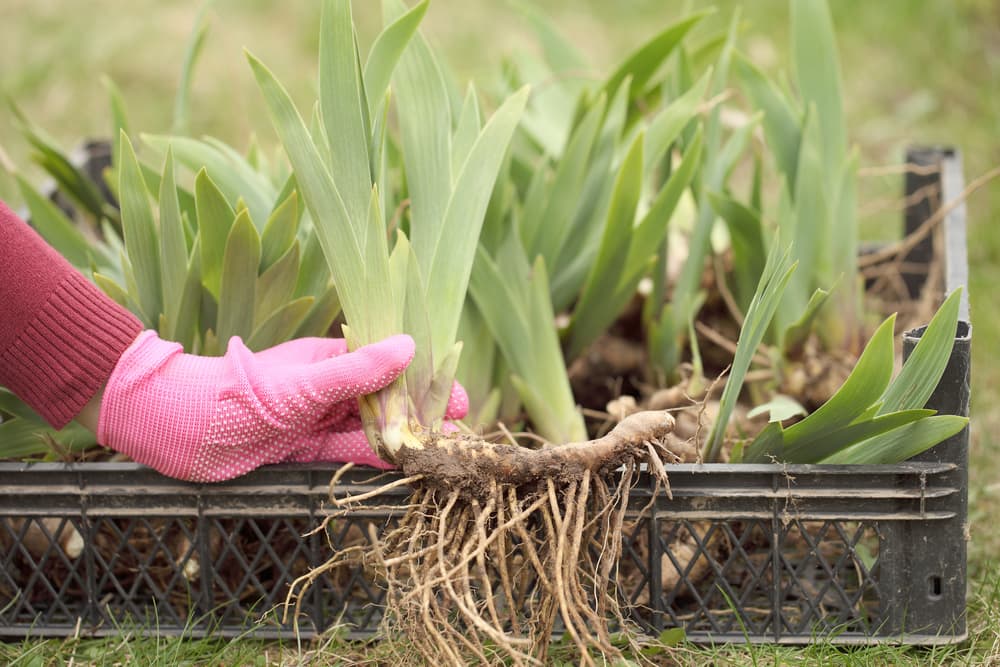
The advantage in doing so is that a beginner can easily tell which way to plant the rhizome in a bed by simply ensuring that the leaf fan is directed away and outside from other Irises or rhizomes with each one’s ‘nose’ being directed inwards, or place the rhizome such that all are oriented in the same direction.
When choosing a spot to plant your iris rhizomes, Simon recommends a hot and sunny place in your garden – “the hotter, the better.”
He also highlights the importance of planting your rhizomes in a growing medium that drains well.
“Make sure your soil is free draining. Bearded Irises are susceptible to rhizome rot and the best way to avoid this is to plant your irises in a good gritty mix.
“Irises will do well in clay soil but, again, it is essential to add a peat-free compost and lots of pea shingle.
“If the land is heavy, add a layer of brick rubble and coarse gravel to the base of the bed.”
Mid to late summer is the perfect season for planting rhizomatous Iris:
- First, loosen the soil down to 30-35cm and enrich or amend as required.
- Make a shallow planting hole within which form low, loosely-packed mounds or ridges where you intend to plant the rhizomes.
- Place a rhizome on the mound or ridge, and carefully spread out its roots evenly.
- Water very moderately and fill in the hole without packing in the soil such that the upper part of the rhizome to about a good centimetre stays open and exposed. This is to ensure your iris blooms the following year, Simon explains.
- Continue planting other rhizomes similarly.
“Plant your irises 23-30cm apart in groups of three per variety, with 46cm spacing between each group,” advises Simon.
“Choose a mix of varieties that extend the bloom period, with a selection of early, mid and late flowering varieties.”
The closer the rhizomes, the more spectacular the visual impact but you will need to separate and divide the rhizomes within a couple of years.
The further apart the rhizomes are, the greater the number of years you can leave them be to naturalise but you will have obvious gaps between the plants.
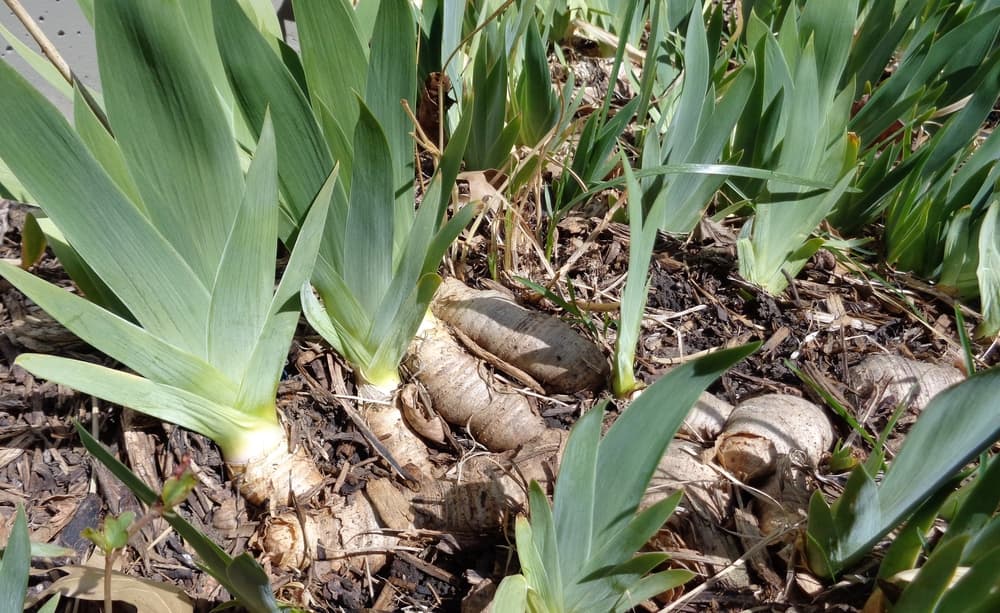
30cm is a smart compromise.
Now give the area of planting a good soaking and firm up the soil on the sides of the rhizomes (but not above them) so that rhizomes and plants are held in place.
Bearded Iris Care
Irises should be planted in full sun. Leaving aside the plant, Iris rhizomes need sun and also good air circulation, as Master Horticulturist Peter Lickorish explains:
“The need for sun to reach the rhizomes cannot really be overstated, in my opinion.
“Because of this, planting in a dense, mixed border can be challenging, so I find planting in a bulb border of mixed bulbs for different seasons can work well.
“Iris rhizomes, along with many bulbs including tulips, require similar free-draining conditions and because bulb foliage is only seasonal, it does not cast dense, long-lasting shade over rhizomes.
“To look extra neat when planting many rhizomes, find the north end of the bed and plant the rhizomes so their tips are facing this end, so each rhizome bakes on the south-facing side.
“I find they look very satisfying when they all face the same way.”
Soil Requirements
A fertile, clay-free loam enriched with humus or compost is ideal for Irises.
No matter what the soil, it must drain very well – it is preferable for the soil to have some gravel or similar amendment that will assist in drainage.
Soil pH a notch or two from 7.0 is perfect though anything from Slightly Acidic to Slightly Alkaline is fine.

Watering & Feeding
Rhizomatous Irises are a little too often made out to be water-guzzling plants but in reality, in most areas of the UK, they will need only moderate or supplemental watering.
Use a bone meal feed when you plant or opt for a seaweed feed if foxes are a problem, says Simon.
“Feed them in spring and autumn.”
Avoid feeding Irises with nitrogenous fertiliser.
An organic or liquid 5-10-10 or plain organic compost are ideal for Irises.
Dividing
On a periodic basis, as and when necessary, the clumped-up rhizomes will need to be divided.
With the rhizomes visible at the soil surface, you will know when the rhizomes have become dense it’s time to get down to business; however, every four years is a good rule of thumb.
The end of summer is the right time for dividing rhizomes.

Do not divide rhizomes when the soil and rhizomes are wet or damp.
- First, remove the soil from around the rhizomes.
- Be sure to carefully loosen a rhizome’s roots and gently lift them, and (only) then pick up the rhizome.
- You will be able to see a narrower collar-like ‘join’ at an angle on most rhizomes.
- Simply break or pull apart the rhizome at this ‘join’.
Large and long rhizomes may be divided with a sharp, sterilised knife.
Pruning & Deadheading
Spent flowers should be deadheaded.
In particular, be watchful for seed pods lest your garden gets seeded with Iris plants that will remain unproductive for a good few years.
“Do not cut back the flowering spike after flowering,” says Simon.
“Allow it to die back naturally, then break it softly by placing your thumb at the base of the flowering spice and push until you hear a ‘crack’!
“This ensures a smooth break at the base of the plant and prevents ingress of water down a cut flower spike.”
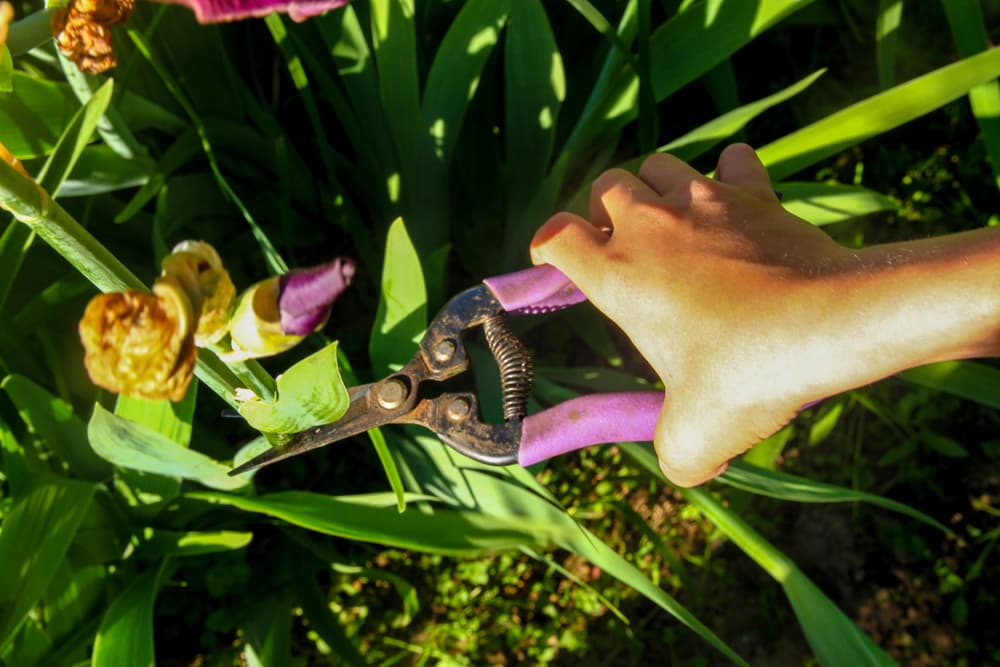
You should not cut back the foliage at this time as the leaves will continue to photosynthesise through autumn, to generate energy which is shipped back to the rhizome for the following year’s blooms.
However, you can certainly trim unsightly tips and tatty leaves.
“Good plant hygiene is essential before the onset of winter,” explains Simon.
“In late Autumn or when the leaves have stopped growing, remove all old leaves from the base of the rhizome.
“Then, I’d recommend that you trim the leaves back into a fan shape 10-15cm tall and cut back any old or rotten rhizomes.”
As Simon suggests, as soon as the leaves have withered and browned they should be cut back.
Common Problems
“Irises are drought-tolerant and resistant to most pests and diseases, but in late autumn, check for slugs,” Simon says.
“Small black varieties are particularly troublesome. Apply non-toxic pellet ‘Ferrimax’ or an appropriate equivalent if present.”
Iris borers and soft rot are the two other serious problems that can afflict this rhizomatous plant, though this is not usually an issue here in the UK.
Soft Rot
Soft rot is caused by a bacteria which infects Iris rhizomes under favourable conditions of climatic warmth and dampness.
If some rhizome exudes a foul, rotting smell and is soft to the touch, it is almost surely soft rot.
Other symptoms are the central leaves first yellowing and wilting, signs of decay at their bases, and then the whole fan withering.
To address the problem, do as follows on a sunny, dry morning.
Cut off the affected part of the rhizome and a little more besides with a sharp, sterilised knife such that the remaining rhizome displays healthy tissue and does not have any foul smell.
If the affected part is too large, the entire rhizome will have to be removed. Also scoop up all the nearby soil.
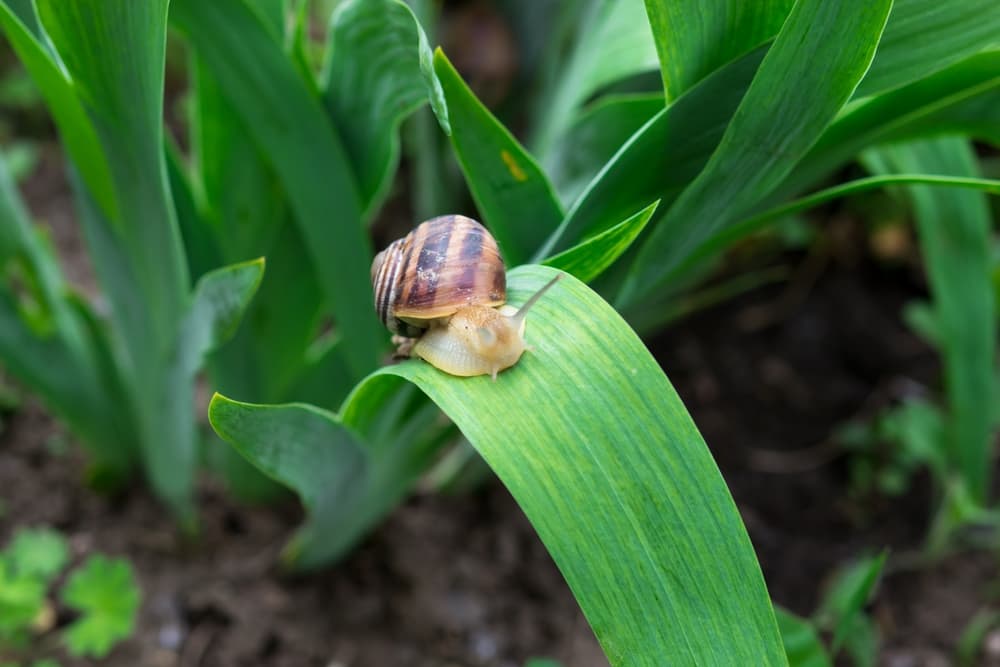
Lightly coat the newly-cut surface and edges with garden sulphur (and put some in the surrounding soil) and leave the rhizome exposed to the sun for the entire day.
Other than these two critical problems, Irises may be affected by a less serious problem namely aphids, and those garden nuisances, slugs and snails.
References
- 1Iris x germanica. (n.d.). North Carolina Plant Toolbox. Retrieved March 13, 2023, from https://plants.ces.ncsu.edu/plants/iris-x-germanica/
- 2Iris × germanica. (n.d.). Kew Royal Botanic Gardens. Retrieved March 13, 2023, from https://powo.science.kew.org/taxon/urn:lsid:ipni.org:names:438637-1

